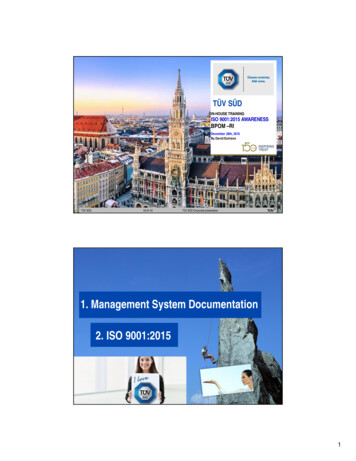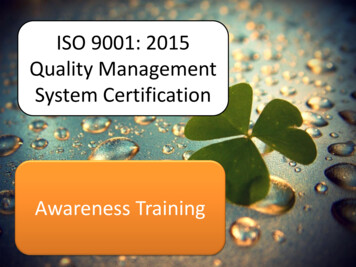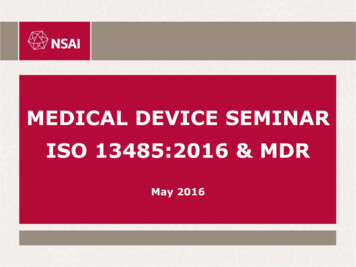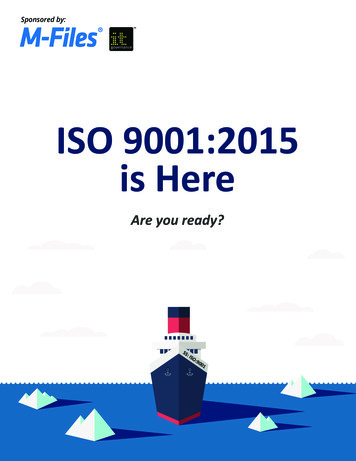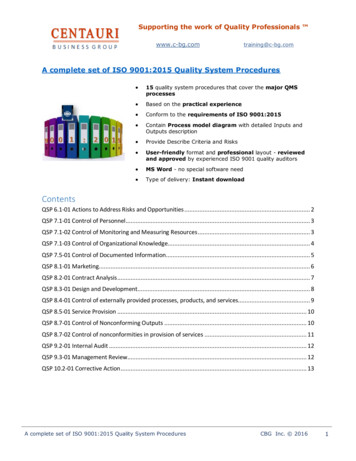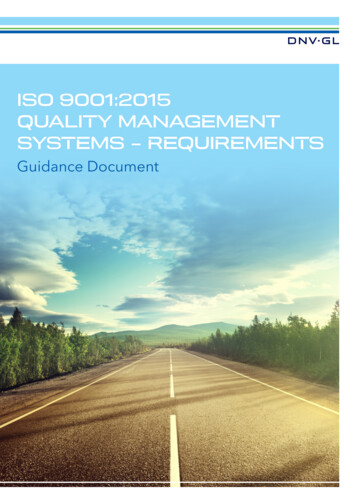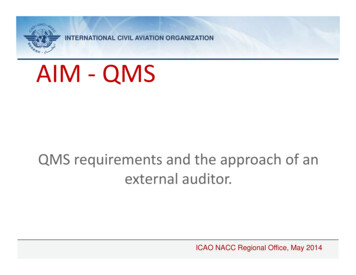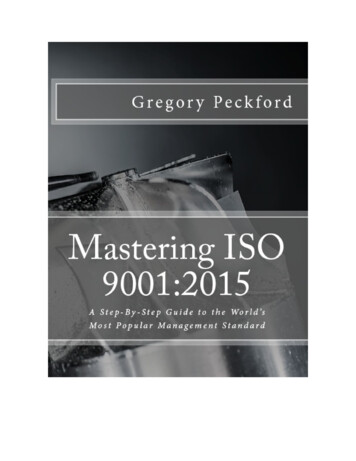
Transcription
Mastering ISO9001:2015A Step-By-Step Guide To The World’sMost Popular Management StandardGregory Peckford
Copyright 2016 Gregory PeckfordAll rights reserved.ISBN: 1537422731ISBN-13: 978-1537422732
DEDICATIONThis book is dedicated to my amazing wife and best friend Aileen, for hersupport and unwavering belief in my ability to accomplish my goals evenwhen my own vision is less than clear.And to my parents Tom and Marie who have always been my biggest fans.
CONTENTSChapter 1Seven (7) Quality Management Principles. 16Process Approach . 18Plan Do Check Act Cycle (P.D.C.A.) . 21Chapter 2Risk-based thinking . 23Revision changes and making the transition . 26Chapter 3Clause 1: Scope . 29Clause 2: Normative references / 3 Terms and definitions . 30Chapter 44.1: Understanding the organization and its context . 344.2: Understanding the Needs and expectations of interested parties . 384.3: Determining the scope of the quality management system . 404.4: Quality management system and its processes. 43Chapter 55.1 Leadership and commitment . 485.1.1 General. 485.1.2: Customer focus. 525.2: Policy (Quality Policy) . 535.2.1: Establishing the quality policy . 53
Gregory Peckford5.2.2: Communicating the quality policy . 545.3: Organizational roles, responsibilities and authorities . 55Chapter 66.1: Actions to address risks and opportunities . 606.2: Quality objectives and planning to achieve them . 626.3: Planning of changes. 65Chapter 77.1: Resources . 687.1.1: General. 687.1.2: People. 697.1.3: Infrastructure . 697.1.4: Environment for the operation of processes . 717.1.5: Monitoring and measuring resources . 727.1.6: Organizational knowledge . 757.2: Competence . 767.3: Awareness . 777.4: Communication. 807.5: Documented information . 827.5.1: General. 847.5.2: Creating and updating . 857.5.3: Control of documented information . 85vi
Mastering ISO 9001:2015Chapter 88.1: Operational planning and control . 908.2: Requirements for products and services . 938.2.1: Customer communication . 938.2.2: Determining the requirements for products and services . 958.2.3: Review of the requirements of products and services . 968.2.4: Changes to requirements for products and services . 998.3: Design and development of products and services . 998.3.2: General. 998.3.2: Design and development planning . 1008.3.3: Design and development inputs . 1028.3.4: Design and development controls . 1048.3.5: Design and development outputs . 1068.3.6: Design and development changes . 1088.4: Control of externally provided processes . 1098.4.1: General. 1098.4.2: Type and extent of control . 1128.4.3: Information for external providers . 1148.5: Product and service provisions . 1158.5.1: Control of production and service provisions. 1168.5.2: Identification and traceability . 1198.5.3: Property belonging to customers and external providers . 120vii
Gregory Peckford8.5.4: Preservation. 1228.5.5: Post-delivery activities . 1238.5.6: Control of changes . 1248.6: Release of products and services . 1258.7: Control of nonconforming output. 127Chapter 99.1: Monitoring, measurement, analysis and evaluation . 1329.1.1: General. 1339.1.2: Customer satisfaction . 1349.1.3: Analysis and evaluation . 1379.2: Internal Audit . 1409.3: Management review . 1489.3.1: General. 1489.3.2: Management review inputs . 1499.3.3: Management review outputs . 152Chapter 1010.1 General . 15710.2 Nonconformity and corrective action . 15810.3 Continual improvement . 164viii
Mastering ISO 9001:2015PREFACEWelcome to Mastering ISO 9001:2015 where you will learn theconcepts and fundamental principles of the world's most popular,and widely utilized quality management standard. I created MasteringISO 9001:2015 to help professionals elevate their careers andorganizations improve business performance through the use ofquality management. One of the key decisions I made in my owncareer, one that has been instrumental in my professionaldevelopment, was learning the ISO 9000 group of standards anddeveloping that knowledge into a thriving career in qualitymanagement.But you do not have to be a quality management professional orauditor to take advantage of the information contained within thisbook. ISO 9000 can help to improve your own company's processeson any level, whether you're the CEO or a department manager. ISO9000 can also provide you with valuable tools to make you a betterdecision-maker within your organization. For me, becomingproficient in the ISO 9000 family of standards has allowed me toprogress in my career, not only as a quality management professional,but also as a corporate and project level manager in multipleindustries. ISO 9000 allowed me to expand on the valuable technicalknowledge I had developed throughout my career and adapt thoseskills to any situation.In this book you will be introduced to the ISO 9000 family ofstandards, and learn the benefit that this knowledge can have on yourbusiness, organization and your career. We will discuss the 7fundamental Quality Management principles that form the basis forthe ISO 9001:2015 standard. We will cover the concepts andimportance of process approach and the Plan-Do-Check-Act cyclewhen developing and implementing a quality management system.Also, we will discuss the concept of risk-based thinking, and thexi
Gregory Peckfordimportance ISO 9001:2015 places on building this into the wholemanagement system in order to better manage risk and takeadvantage of possible opportunities. Now that the newest version ofthe ISO 9001 standard has been released we will discuss thetransition process from the 2008 to 2015 revision. And of course, wewill go through the ISO 9001:2015 standard in detail, clause byclause, so that you will walk away with a solid understanding of thiswidely utilized and diverse quality management system criteria, whichwill allow you to not only improve business performance, but alsoincrease your professional value and diversify your career potential.So, just what are the ISO 9000 series of standards and what arethe benefits of incorporating these guidelines into your business orprofessional toolkit? ISO 9000 is a set of globally recognizedstandards for quality management. The standards are purposelygeneric in nature, even more so with the latest 2015 revision, as theyare meant to apply to any industry or organization regardless of sizeand product or service offered. So basically, if you understand theprinciples of the ISO 9000 series of standards, you should be able toapply those concepts to any business. Many people see ISO 9001 as amanufacturing standard, but due to its generic nature, it is muchmore than that and can be implemented in any product or servicebased business. And now with the release of the ISO 9001:2015revision, this diversity has been made even more apparent.So why is ISO important? What are the benefits for businesses inimplementing these standards and for individuals in learning andbecoming proficient in this knowledge? ISO standards providebusinesses with a valuable toolkit to not only improve quality, butalso increase efficiency and productivity in their processes. Itprovides a guideline to enhance customer satisfaction, reduce risk,take advantage of opportunity, and in turn increase sales andprofitability. For the individual, proficiency in the ISO standard canprovide a skill set to help your organization implement strategies toxii
Mastering ISO 9001:2015reach these desired goals and advance your professional value. I thinkit's pretty clear that if you are able to provide valuable input andimprove your organization's processes, as well as help them becomemore effective, then your career can only prosper.xiii
14
Mastering ISO 9001:2015CHAPTER 1ISO 9000 SERIES OF STANDARDS“If you don't drive your business, you will be driven out ofbusiness.”-B. C. ForbesSo we touched on what the ISO 9000 series of standards are as awhole, now I would like to go into the individual standards that makeup the 9000 family and how they can be used as an integrated set formaximum effectiveness. ISO 9000:2015 covers the basic concepts and language usedin the standard by providing the terms and definitions foundthroughout. ISO 9001:2015 sets out the requirements of a qualitymanagement system and is the only standard in the ISO 9000family that can be certified or audited to. ISO 9001 is themain document and contains the 10 relevant clauses thatmake up the standards criteria – and is what we will focus onin the majority of this book. Keep in mind that ISO 9001 is ageneric standard and is not intended to dictate how a businessis to be run. Implementation is up to the organization and isbased largely on the company's scope of business. What's15
Gregory Peckfordimportant is that the requirements are met in order to obtaincertification or to effectively benefit from its implementation. ISO 9004:2009 provides guidance over and above therequirements included in ISO 9001 and also containsguidelines for self-assessment and is not intended forcertification purposes. ISO 9004 focuses more on increasingthe effectiveness and efficiency of a quality managementsystem. ISO 19011:2011 provides a guideline for conducting andmanaging internal and external audits of a qualitymanagement system. This is a great resource for anyoneinvolved in the audit process.Seven (7) Quality Management PrinciplesISO 9001 is based on 7 quality management principles which aredefined in ISO 9000:2015 and ISO 9004:2009 and are intended toprovide senior management with a framework for improvingperformance within the organization. Let's take a look at each one ofthose principles right now.1. The first quality management principle is customer focus, and itmaintains that organizations should understand current andfuture customer needs and requirements and always strive toexceed expectations. I think it goes without saying that if youcan focus on the customer's needs and constantly find waysto improve how you deliver on those needs, you will seeincreased revenue and repeat business.16
Mastering ISO 9001:20152. The second principle is leadership; we all know that strongleadership is key in the success of any business. Leaders in anorganization set the direction and create an environment forpeople to buy in and get involved and be motivated inachieving established organizational objectives. Thispromotes unity and effective communication.3. The next quality management principle is engagement of people;and this ties in with the previous principle, which wasleadership. Leaders set the tone, but the benefits are trulyapparent when you have full involvement of the people at alllevels of the organization. Having this involvement promotesinnovation, creativity and accountability among otherbenefits.4. The fourth principle is a process approach; and we will discussthis in more detail coming up, but by managing resources andactivities as a process, a desired outcome can be obtained farmore efficiently and effectively while improving cost andachieving predictable and consistent results.5. Next we have improvement; which unfortunately is highlyoverlooked by many organizations, but should be a highfocus area and a constant objective for improvement at alllevels of organizational performance.6. The 6th quality management principle is a key element ofeffective management and that is evidence-based decision making;making informed, fact-based decisions, through carefulanalysis that can be backed up with data and availableinformation.7. And the final quality management principle that forms thebasis for the ISO 9000 group of standards is relationship17
Gregory Peckfordmanagement; realizing that the organization and its externalpartners must have an interdependent relationship thatpromotes value. Both have a stake in the game and mustwork together to achieve consistent and yet flexible results tocreate value for both parties.So these are the 7 principles for quality management thatstructure the ISO 9001:2015 standard, and although these are notauditable requirements, it is wise that an organization build off ofthese principles when developing a quality management system.Process ApproachThe process approach has always been a very important part of theISO 9001 standard and this has not changed in the 2015 revision.ISO strongly encourages organizations to adopt a process approachwhen developing and implementing a quality management system,and asks that top management exercise leadership by promoting anawareness of this approach. But what exactly does this mean? Aprocess is an activity or set of activities that uses resources and ismanaged in order to enable the transformation of inputs intooutputs. The process approach is a management strategy; whenmanagement chooses to implement a process approach, it means thatthey manage and control the processes that make up theirorganizations, the interactions between these processes, and theinputs and outputs that tie these processes together as a coherentsystem. It is essential that processes be monitored and measured foreffectiveness throughout all stages.So what does applying the process approach in a qualitymanagement system enable? It aids organizations in the betterunderstanding of requirements whether they are customer,contractual or regulatory, and the importance of maintaining18
Mastering ISO 9001:2015consistency in meeting those requirements. It helps organizationsview its processes in terms of requirements, and a means to meetthose specific requirements. A process approach helps to ensureprocess performance is achieved effectively and continues to meet itsdesired goal efficiently and consistently, and helps organizationsimprove on process performance based on the evaluation of data andinformation gathered through continuous monitoring activities. (SeeFigure 1)19
Gregory PeckfordFigure 1: Elements of a process20
Mastering ISO 9001:2015Plan-Do-Check-Act Cycle (P.D.C.A.)In addition, ISO recommends applying the PDCA or Plan-DoCheck-Act methodology in the development of a quality managementsystem and its processes. This methodology provides a repeatingcycle of action and monitoring that promotes continuousimprovement and effective process management. The four-step cycleconsists of the following: Plan - Planning your objectives, activities and resourcesnecessary to develop effective processes that will meetrequirements. Do - Do what you planned in the previous step andimplement the processes. Check - Check or monitor the process for effectivenessagainst established requirements and record the results. Act - Act on the data collected while monitoring the processand make the required adjustments to continually improvethe process.Continue to repeat this cycle to maintain process effectiveness, asbusiness needs change.21
Gregory Peckford22
Mastering ISO 9001:2015CHAPTER 2“Happiness does not come from doing easy work but from theafterglow of satisfaction that comes after the achievement of adifficult task that demanded our best.”-Theodore Isaac RubinIn this chapter we will discuss the concept of risk-based thinking, andthe importance ISO 9001:2015 places on building this into the wholemanagement system in order to better manage risk and takeadvantage of possible opportunities. Also, in Chapter 2 we willdiscuss the transition process from the 2008 to 2015 revision, andwhat that transition means for an organization.Risk-based thinkingOne of the key changes in the 2015 revision of the ISO 9001standard is the addition of risk-based thinking. Making risk inherent inall aspects of a quality management system as opposed to treatingpreventive action as a separate component to be considered inisolation. Of course, risk has always been a factor in ISO 9001, butnow it has been given more of an integral role in the latest revision,and organizations are now required to plan and implement processesto address risk, and it is something that should be considered in all23
Gregory Peckfordaspects of an organization's quality management system. Somethingto note is that with the addition of risk-based thinking, the section onpreventive action (Section 8.5.3 of ISO 9001:2008) has becomeredundant and removed in the 2015 edition. Organizations areencouraged to consider risk in terms of negative and positiveoutcomes. It is common sense that you would want to identifynegative scenarios and plan to mitigate against them, however it isequally important to identify possible opportunities that may ariseand take advantage of those opportunities for positive growth.Let’s look at this from a more practical perspective. Let’s say forexample, you are planning a family vacation, by implementing riskbased thinking, you would consider the risks involved prior tobooking your trip: You might decide against purchasing flight insurance in orderto reduce the cost of your plane ticket. Is the risk ofcancellation and losing the cost of the ticket acceptable? What is the weather generally like in your city of departureand arrival at the time you plan to travel? Is there a chance of severe weather that could affect yourtravel plans? What about illness? Is there a risk of disease or sickness thatis common to the area you plan to visit? Are therevaccinations available to help prevent contracting such anillness prior to taking your trip?Alternatively, there are possible opportunities to consider such as: If you are flexible with your travel dates, you could takeadvantage of flight, or hotel sale prices that are only availableat certain times. What activities, or special events are taking place, which youcould attend if you are aware of them in advance?24
Mastering ISO 9001:2015These are things we would normally consider in our daily lives, sowhy would we not take the same approach in business?So now that we understand the concept of risk-based thinking,how do we incorporate this into a quality management system?I. The first step is to identify risks and opportunities dependant on thecontext of the organization, and scope of the QMS. Until risk andopportunity have been adequately identified, it is impossibleto factor this into process development.II. Once identified, organizations can begin to assess and understandthese risks and opportunities, and make determinations on what isacceptable and what is unacceptable, as well as theopportunities to be taken advantage of – planning actions toaddress these risks and take advantage of possibleopportunities.III. Determining the options available in order to adequately mitigaterisk factors and the necessary steps required.IV. Then take action, and implement the strategies developed during theplanning stage, and incorporate these actions into businessprocesses.V. Lastly, organizations must assess the effectiveness of these actions, andlearn from the collected data in order to refine processes forcontinuous improvement.25
Gregory PeckfordRevision changes and making the transitionOK, so let's take a look at some of the key changes with ISO9001:2015. On September 23, 2015, ISO released the latest revisionto the ISO 9001 standard. So I thought it would be a good idea togive you a brief explanation of the changes, and what effect thosechanges will have on organizations, and the people who have theresponsibility of implementing, managing and auditing the newstandard. While many of the concepts from the 2008 version of thestandard remain, there are some significant changes, and additions, tothe 2015 edition, which we will take a closer look at right now. One of the more obvious changes to the 2015 revision is inthe look and structure of the standard itself. In an effort tomaintain consistency across multiple ISO managementsystems, the latest revision takes on the new Annex SL formatthat is shared by other standards such as ISO 14001Environmental Management Systems. Both the IS0 14001,and new ISO 9001:2015, share the same clause structure, toallow organizations the ability to implement, and integratemultiple management systems more easily and effectively. As discussed earlier, the ISO 9001:2015 revision promote theincorporation of risk-based thinking within the managementstructure of the organization. This is not to be confused witha stand-alone risk management procedure, but theincorporation of risk awareness and identification throughoutthe system as a whole. Top management are now required to develop processes thatallow foresight and planning for possible risk factors that mayhave a negative impact on process and performance, as well26
Mastering ISO 9001:2015as identify and take advantage of possible opportunities. Asmentioned earlier, with the addition of risk-based thinking,the section addressing preventive action, sub-clause 8.5.3 inISO 9001:2008, has been deemed redundant, and thereforeremoved from the 2015 revision. Another change in ISO 9001:2015 is greater emphasis onLeadership, and Management Commitment. The newstandard is intended to promote integration and alignmentwith business processes and strategies. With this integration,top management now have more responsibility in taking on aproactive role in the health and promotion of the qualitymanagement system. The requirement for a single point ofcontact or management representative regarding the QMS hasbeen removed, and a new section on leadership has beenadded to better emphasize a greater involvement from theleadership team. Another notable change is the replacement of the term“product” with “product and services”, which is intended to betteraddress service-based organizations. Along with the change in the term “product”, the 2015 revisionalso replaces the common terms “documents” and “records” with“documented information”. Organizations are required to retaindocumented information as evidence of the implementationof the audit program and audit results. ISO 9001:2015 has no specific requirement fordocumentation of procedures, leaving it up to theorganization to define their own needs for documentation,while taking into consideration client and regulatoryrequirements.27
Gregory Peckford In ISO 9001:2008 there were 6 required documentedprocedures that every organization must have as part of itsQMS. This is no longer a requirement in the 2015 edition.This is not an exhaustive list of amendments to the new versionof the standard, but a high-level look at the new content andstructure of the newly released standard.The new ISO 9001:2015 standard has been formally released forpublic consumption and implementation; however, organizations arenot expected to be compliant to the new changes immediately.Organizations have been granted a 3-year transition period beforecompliance to the new standard is required, for those that maintaincertification to ISO 9001:2008. So don't throw out your copy of theexisting 2008 standard just yet! Organizations and qualityprofessionals are urged to become familiar with the newrequirements, and perform gap analysis of their current system todetermine the steps required for eventual implementation of the new2015 revision by September 2018. Once the gaps have beenidentified, it is important to develop a plan for closing the gaps, anddetermining the steps and resources required to meet therequirements of the new standard. It is also imperative to providetraining and awareness of the new requirements, and actionsnecessary to meet those requirements, so that all personnel are on thesame page and moving in the same direction towards theorganization's goals – and of course, implementation of the plan, andupdating of the existing QMS to meet the requirements of ISO9001:2015.28
Mastering ISO 9001:2015CHAPTER 3“Markets change, tastes change, so the companies and theindividuals who choose to compete in those markets mustchange.”-An WangIn this chapter, I will introduce you to the standard content itself, andtalk about the first 3 clauses of the ISO 9001:2015 standard. Thesefirst sections are very short with minimal content, and essentiallyprovide a reference to other documents included in the ISO 9000family that have been referenced, and form as support for thestandard itself. It also provides the scope of the standard, and laysout the general purpose, and where and when the standard applies toan organization.So let's get started!Clause 1: ScopeThe first clause which defines the scope of the standard itself asspecifying the requirements for a quality management system thatenables an organization to demonstrate its ability to consistentlyprovide a product or service that meets customer, regulatory andstatutory requirements, and aims to enhance customer satisfactionthrough the effective application of the system, processes for29
Gregory Peckfordcontinuous improvement of the system, and assurance of conformityto requirements. This should not be confused with the scope of aquality management system itself, which should be based on thenature of the organization's products and services as well as theirrealization processes, the result of risk assessment, commercialconsiderations, and contractual, statutory and regulatoryrequirements.Section 1 also highlights the broad range and flexibility of theISO 9001 standard, stating that all requirements of the standard aregeneric, and applicable to all organizations regardless of type, size orproduct & service offered. This diversity in application has beenmade even more apparent in this latest 2015 revision of the standardby becoming less prescriptive, and highlighting the applicability toservice-based organizations, as opposed to product alone. So ISO9
Mastering ISO 9001:2015 15 CHAPTER 1 ISO 9000 SERIES OF STANDARDS “If you don't drive your business, you will be driven out of business.”-B. C. Forbes So we touched on what the ISO 9000


